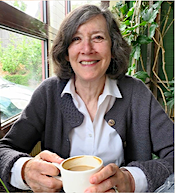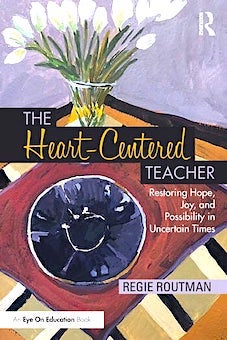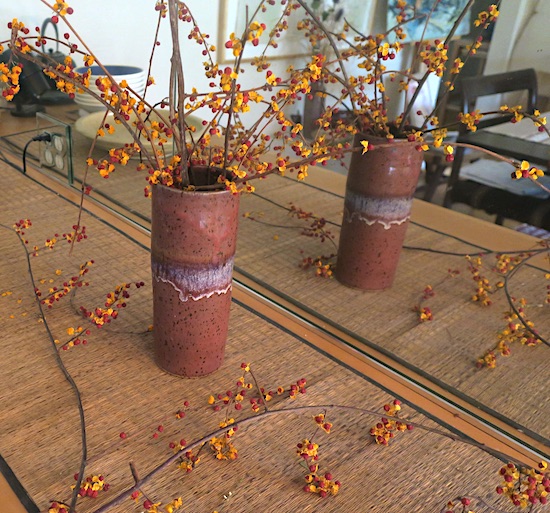Thanksgiving: A Time of Gratitude and Generosity
By Regie Routman
 “Gratitude and generosity need to be part of our curriculum and to ground our important conversations.”
“Gratitude and generosity need to be part of our curriculum and to ground our important conversations.”
A teacher posted that quote on Twitter (X) from my book The Heart-Centered Teacher: Restoring Hope, Joy, and Possibility in Uncertain Times (Routledge, p. 208) as being especially consequential. I agree. If I had to name the most important mindsets and actions for living a full and flourishing life, I’d say gratitude and generosity are at the top and are especially essential for living and thriving in challenging times.
All of which gets me thinking about Thanksgiving, our family’s favorite holiday. Our shared memories and rituals go back decades – the beautiful setting we strive to create; the favorite dishes we prepare; the welcoming atmosphere; the gathering around the table with loved ones, and – of course – the stories, almost all of which are food related.
Toby’s Thanksgiving Feast
One of our most memorable holiday tales happened decades ago. It was late afternoon the day before Thanksgiving, and Betsy Brown, a dear friend and neighbor, had stopped by for a brief visit. We were chatting in the living room when I suddenly realized that Toby, our beloved wire-haired dachshund, had been unusually quiet.
It was a mild day, and the frozen turkey we’d purchased for the holiday was defrosting on a small, side porch connected to the kitchen. Somehow, the door from the kitchen to the porch was ajar; Toby had gotten out and was blissfully eating his way through our still-raw turkey. Not only was I exasperated with our dog – even as I anguished about how sick he was likely to be – I was distraught knowing that we had 10 people coming for Thanksgiving and no longer had a viable bird.
That’s when Betsy intervened: “Look. My family and I know Toby well and can vouch for him. As we’re having a small family gathering, I’ll cook your turkey and bring you our large, uncooked turkey.” And that’s what she did. A lovely act of kindness and generosity. I still feel a rush of gratitude each time I recall that story.
Calming Rituals with Our Students
One of my fondest Thanksgiving memories growing up was having my grandmother with us at the extended dining room table, a table that was enhanced each holiday by the gorgeous, crocheted tablecloth she had spent eight years creating. My grandmother was a practical person, so she made sure the tablecloth was washable, in a washing machine on a gentle cycle.
My grandmother reminds me that beautiful, handmade settings and crafts matter, that some things cannot be rushed, and that the people we love who are no longer with us are present through their stories, gifts, and memories of past holidays together.
For our students who may not be gathering with family and/or friends for a Thanksgiving dinner or other holidays, consider incorporating some kind of ritual in the classroom and creating pleasurable memories and new stories together. They need not be about food. It could be as simple as writing poems about what we’re grateful for, for perhaps more than anything else, Thanksgiving is a holiday about shared gratitude.
It could be expressing aloud positive sentiments for a person we appreciate and giving the reasons why, or writing a short note to someone we are grateful for. Especially these days, when so many students, teachers, and families are experiencing or recovering from anxiety, isolation, and/or trauma, creating a beautiful and peaceful environment of gratitude and generosity can be calming and healing.
Our Traditions Bring Us Joy
In large part, our family enjoys celebrating Thanksgiving because of the traditions and rituals we lovingly embrace. Routines are important too, necessary actions we take to keep our lives organized and orderly, but rituals are where the joy is.
Some of our rituals are stringing cranberries for decorations, setting a beautiful table, making tried-and-true favorite dishes, and adding some new ones. Much of the cooking now is enthusiastically shared with family members and other guests. One way we show our gratitude and generosity for those who are around the table is to cook more than we can eat so everyone goes home with delicious leftovers. As I have long viewed cooking as an act of love, I always make too much, and it’s my pleasure to share that abundance with our guests.
Especially joyful for me is making the cranberry sauce and the stuffing. The cranberry sauce is my mom’s recipe; I can still picture her making it, year after year. After she died, I took over making it, and I have shared the recipe with many friends through the years. Sharing it with loved ones is part of the joy. In fact, our friend Kevin is stopping by again, as he did last year, to pick up a quart jar. He texted me, “I will come by for your spectacular cranberry sauce. I have been dreaming of it since I used up my last bit last year.”
I’m happy to share the recipe with you as well. It’s easy to make. I cook the cranberries with freshly squeezed orange juice instead of water, and add chopped pears, apples, and ample cinnamon. (The cranberry sauce recipe is on the accompanying website to The Heart-Centered Teacher under Recipes, along with a recipe for butternut squash soup, which is also a family favorite.)
The stuffing recipe, using homemade croutons, is one I created many years ago and that we all love. Part of that love is knowing that our particular stuffing is now generational and will, most likely, continue to be. Family traditions, especially around food, are one way many of us celebrate our unique holiday cultures. While I was the original stuffing maker, my granddaughters Katie and Brooke made the stuffing with me for many years, and now Katie has taken over that role.
Just like in the classroom, where we aim for a great end result, demonstrating how to ‘do it’ and then sharing and guiding the experience with learners bodes well for excellent results. Of course, it’s essential that the quality of the ingredients and resources are first rate.
Memories Entwined with Bittersweet
Finally, Thanksgiving for my family – and perhaps yours as well – is a bittersweet occasion. We remember those who are no longer with us through stories and foods we lovingly prepare. The memories we created together are still intact – pleasurable, nostalgic, and tinged with a bit of sadness.
Bittersweet, I would say. Even so. . . bittersweet rituals are important as they remind us of the fragility and impermanence of life, along with the beauty and moments of joy. Bittersweet, if you haven’t seen it, is also a tangible thing. It’s a wild, climbing shrub with beautiful, bright yellow and orange (non-edible) berries on it.
I buy a few branches each year as part of our Thanksgiving set up, an acknowledgment and acceptance that every life is bittersweet in some way – an enterprise of dualities, gladness and sadness, often served up together in unpredictable ways. All the more reason to embrace gratitude and generosity in all aspects of our lives.
Also see Regie’s MiddleWeb post:
Seeing and Celebrating Each Learner’s Gifts

Regie’s teaching and coaching work, including school-based residencies, has focused on diverse, underperforming schools and classrooms across the U.S. and Canada, emphasizing strategies to create and sustain intellectual, joyful, and equitable school cultures where all learners can thrive. To learn more about her books, articles, podcasts, videos, and resources, visit her website. To browse her many articles for MiddleWeb, click here.





































